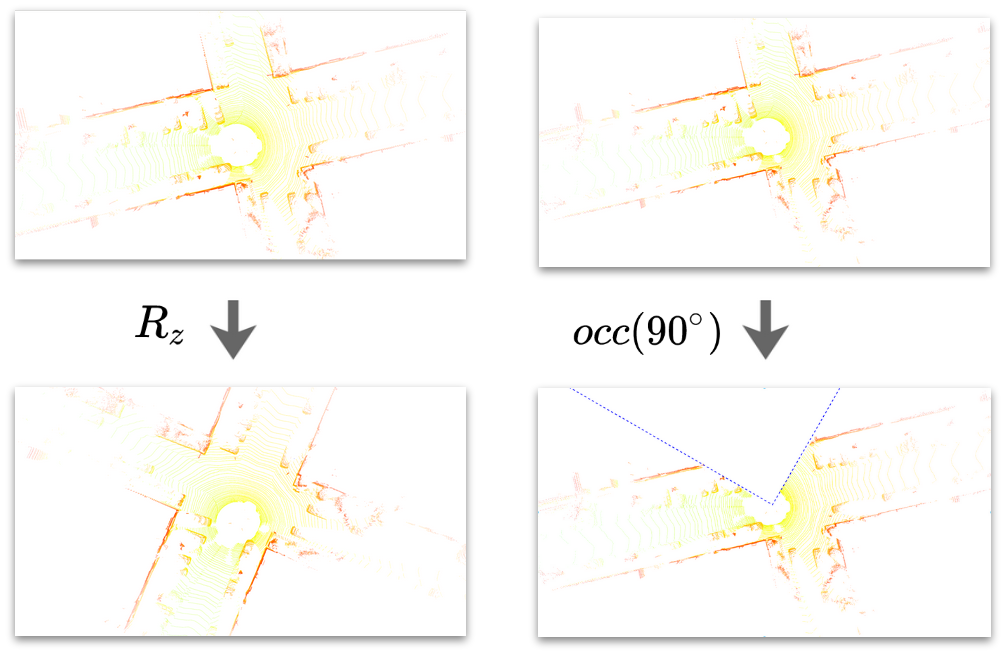Locus
This repository is an open-source implementation of the ICRA 2021 paper: Locus: LiDAR-based Place Recognition using Spatiotemporal Higher-Order Pooling.
More information: https://research.csiro.au/robotics/locus-pr/
Paper Pre-print: https://arxiv.org/abs/2011.14497
Method overview.
Locus is a global descriptor for large-scale place recognition using sequential 3D LiDAR point clouds. It encodes topological relationships and temporal consistency of scene components to obtain a discriminative and view-point invariant scene representation.
Usage
Set up environment
This project has been tested on Ubuntu 18.04 (with Open3D 0.11, tensorflow 1.8.0, pcl 1.8.1 and python-pcl 0.3.0). Set up the requirments as follows:
- Create conda environment with open3d and tensorflow-1.8 with python 3.6:
conda create --name locus_env python=3.6
conda activate locus_env
pip install -r requirements.txt
- Set up python-pcl. See
utils/setup_python_pcl.txt. For further instructions, see here. - Segment feature extraction uses the pre-trained model from ethz-asl/segmap. Download and copy the relevant content in segmap_data into
~/.segmap/:
./utils/get_segmap_data.bash
- Download the KITTI odometry dataset and set the path in
config.yml.
Descriptor Generation
Segment and generate Locus descriptor for each scan in a selected sequence (e.g., KITTI sequence 06):
python main.py --seq '06'
The following flags can be used with main.py:
--seq: KITTI dataset sequence number.--aug_type: Scan augmentation type (optional for robustness tests).--aug_param: Parameter corresponding to above augmentation.
Evaluation
Sequence-wise place-recognition using extracted descriptors:
python ./evaluation/place_recognition.py --seq '06'
Evaluation of place-recognition performance using Precision-Recall curves (multiple sequences):
python ./evaluation/pr_curve.py
Additional scripts
Robustness tests:
Code of the robustness tests carried out in section V.C in paper.
Extract Locus descriptors from scans of select augmentation:
python main.py --seq '06' --aug_type 'rot' --aug_param 180 # Rotate about z-axis by random angle between 0-180 degrees.
python main.py --seq '06' --aug_type 'occ' --aug_param 90 # Occlude sector of 90 degrees about random heading.
Evaluation is done as before. For vizualization, set config.yml->segmentation->visualize to True.

Testing individual modules:
python ./segmentation/extract_segments.py # Extract and save Euclidean segments (S).
python ./segmentation/extract_segment_features.py # Extract and save SegMap-CNN features (Fa) for given S.
python ./descriptor_generation/spatial_pooling.py # Generate and save spatial segment features for given S and Fa.
python ./descriptor_generation/temporal_pooling.py # Generate and save temporal segment features for given S and Fa.
python ./descriptor_generation/locus_descriptor.py # Generate and save Locus global descriptor using above.
Citation
If you find this work usefull in your research, please consider citing:
@inproceedings{vid2021locus,
title={Locus: LiDAR-based Place Recognition using Spatiotemporal Higher-Order Pooling},
author={Vidanapathirana, Kavisha and Moghadam, Peyman and Harwood, Ben and Zhao, Muming and Sridharan, Sridha and Fookes, Clinton},
booktitle={IEEE International Conference on Robotics and Automation (ICRA)},
year={2021},
eprint={arXiv preprint arXiv:2011.14497}
}
Acknowledgment
Functions from 3rd party have been acknowledged at the respective function definitions or readme files. This project was mainly inspired by the following: ethz-asl/segmap and irapkaist/scancontext.
Contact
For questions/feedback,
[email protected]









